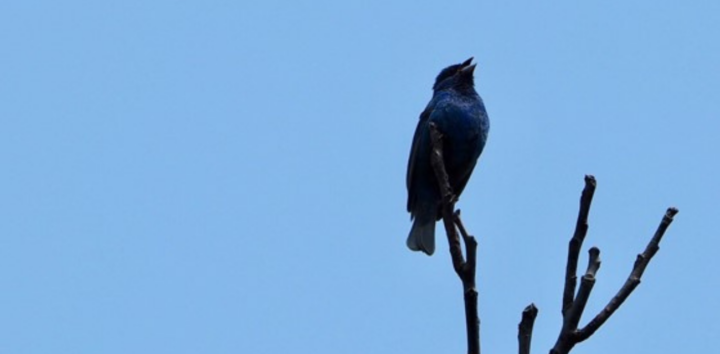Diane Cheklich: 2022 Petoskey Prize winner

Authored by
The ‘heart’ of Detroit Bird City brings residents, birds together
In the wildflower meadow of Callahan Park, you might see the royal gold and purple strut of a pheasant or the iridescence of an indigo bunting or hear a pee-a-wee of, fittingly, the eastern wood peewee.
You also might see Diane Cheklich. She might be on a bench or along the path that cuts through Callahan Park’s meadow. She might be taking photos of robins catching worms or monarchs on milkweed with her long lens camera. Or she might be showing other visitors around.
Callahan Park, by the way, is only two acres. That’s two football fields, a neighborhood block of backyards, the women’s section at JCPenny.
It’s also in the middle of Detroit. It’s a stroll away from old homes, churches, a liquor store, and a sprawling General Motors plant.
And yet, Callahan Park is the home or resting place for 93 bird species and counting. Birds fly far north from Canada and far south from the Caribbean to visit places like this.
While Cheklich didn’t create Callahan Park, she was instrumental in making it into the bird haven it is today. Before, some neighbors thought it was just another vacant lot in their East Poletown neighborhood. Now, they talk about the joy of waking up to birdsong of walking through the meadow.
Callahan was the first project of Detroit Bird City by Detroit Audubon, Cheklich, and several other partners. The group has taken five disused parks in Detroit and turned them into wildlife habitat.
Detroit Bird City has given hundreds of birds a place to rest or nest. But, as importantly, it’s given residents joy, community, and, possibly, better health; and it’s given the City of Detroit a hand in seeing through an ambitious environmental project.
“It’s too well-kept a secret, the bird life that we have here,” Cheklich said. “Part of my mission as I travel through the Detroit Bird City project is to highlight and celebrate that fact.”
For this effort, Cheklich received the 2022 Petoskey Prize for Environmental Leadership at the Michigan Environmental Council’s 24th Annual Environmental Awards Celebration in Detroit’s Eastern Market July 21. One tireless volunteer from one of the Environmental Council’s 80 member groups receives this award each year, and it comes with a $5,000 check for the organization they have dedicated so much time to.

Flight patterns
Detroit is at the confluence of two major flyways: the Atlantic and the Mississippi. Millions of birds use them to migrate north and south as the seasons change.
The birds need a place to rest along the way. Detroit, being so close to great rivers and lakes, serves as a critical stopover for 350 bird species. Without natural habitat in metro Detroit, many birds may struggle to survive.
It is at this confluence of flyways that Cheklich became a birder. She began taking trips with Detroit Audubon across her home city and the metro area, intermingling with devout birders like Detroit Audubon board director Jim Bull and guide book writer Kenn Kaufman.
Eventually, Cheklich joined Detroit Audubon’s board. Right around then, the City of Detroit began analyzing its 300 parks to better allocate limited resources.
It found that some parks were being used in a classic sense of play and leisure, but others had no playground equipment, experienced little foot traffic, or were just in poor places for a park. The City sought to reimagine these spaces in low-maintenance ways. One option was creating and maintaining meadows.
This piqued Cheklich’s and Detroit Audubon’s interest. The turf grass spread out across most parks can make for great places to play but poor places to foster a biodiverse ecosystem. Meadows, however, could support that system.
The City’s proposal was a chance to provide proper habitat for birds migrating and nesting, increasing their chances of survival. It also fit into a larger Detroit Audubon goal.
Checklich calls it “interspecies placemaking,” or using nature to improve the health and happiness of not just birds, but humans, insects, soil, and microbes.
“The more people can realize that we’re all connected, the better it will be not only for ourselves but for the wildlife as well,” she said. “It does not have to be either/or. We’re all in this together.”
Parks-turned-meadows offered Detroit Audubon the chance to prove that nature nearby protects animals, yes, but also instills joy and tranquility, improves health, and creates a sense of community for humans
Cheklich and Detroit Audubon ended up piloting the City’s park-to-meadow program. Five neighborhood parks were surveyed and chosen. This became Detroit Bird City.
With city officials on board, Cheklich and company next worked to hear the perspectives of neighbors living nearby on the project.
Community members liked the idea of having what was essentially an empty lot turned into nature they could easily access. Later, their input would be part of the renovation process.
In June 2019, donated machines came in and tilled the turf grass of Callahan Park, and wildflower seeds provided by the US Fish & Wildlife Service were sprinkled. The next day—Cheklich’s birthday—it rained, but Cheklich was thrilled. It meant the seeds just planted were already being watered.
Three months later, the flowers bloomed. Three years later, Callahan Park has become a place of pheasants and buntings, petals and birdsong, benches and paths.
“It was such a spectacular thing,” Cheklich said.

Migration
After Callahan, Cheklich, and Detroit Audubon began the park-to-meadow process all over again on an old golf course and on three neighborhood parks.
All the work and the results generated excitement in the neighborhoods and in city government. Surveys revealed dozens of bird species and hundreds of people were using the parks. Community groups nearby were drawing inspiration from Detroit Bird City and making their own bird habitats. And all of it was being recorded and shared out by Cheklich, who is a videographer and photographer by trade.
Complimenting Cheklich’s leadership was a study led by Amber Pearson, Ph.D., professor of health geology at Michigan State University. She began measuring the health of nearby residents of Detroit Bird City parks. Her hunch: stress levels would drop and hearts would be made healthier.
With Detroit Bird City’s success in mind, the City’s parks department updated its strategic plan, setting goals to conserve 30% of its land (over 2 square miles) as natural habitat and make it so any Detroiter could get to a park within a 10-minute walk.
Those goals have created more opportunities for Detroit Bird City to continue. Phase 2 seeks to renovate at least four other parks and add 10 acres to the already eight acres in place.
“I think it’s fabulous, and I want to be part of realizing that goal,” Cheklich said of Detroit’s plan. “I give the city credit for stepping up with those ambitious conservation goals, and I think that’s really the best way to do something like this, with property owners themselves and with parallel community initiatives in which Detroit Audubon is connected to.”
Pearson, though, said Cheklich has long been part of realizing the city’s goals. In fact, she’s at the “heart” of them.
“She is the only person who is consistently at all of the meetings and is a huge advocate for this, and really this wouldn’t have happened without Diane,” she said.
Discover
Power environmental change today.
Your gift to the Michigan Environmental Council is a powerful investment in the air we breathe, our water and the places we love.
Sign up for environmental news & stories.
"*" indicates required fields




